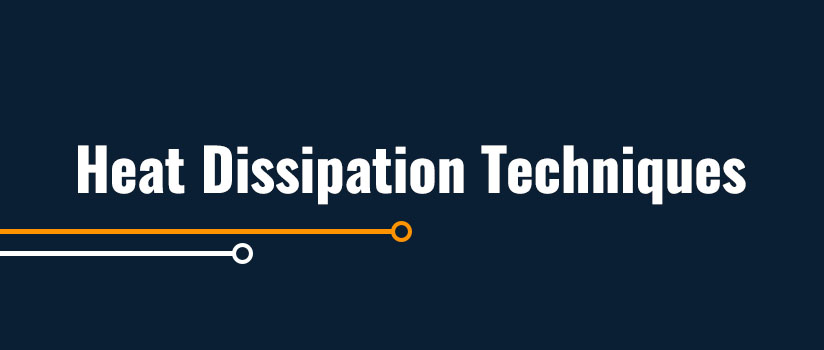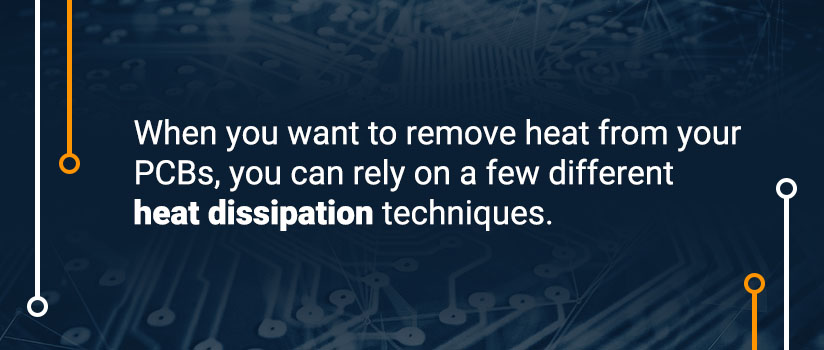When you need to create printed circuit boards (PCBs) for various devices and equipment, one of the main considerations you’ll want to make is how well it dissipates heat. By properly dissipating heat in PCBs, you can safeguard them against performance issues and total breakdowns caused by excess temperatures. Any PCB you invest in should be designed with proper heat dissipation features to ensure it won’t overheat and will provide you with consistent performance.
Find out more about why heat is a problem and some tips for PCB heat dissipation.
Why Heat Is a Problem in PCBs
Whenever a current flows through electronic components, the thermal load increases. The amount of heat the electronic component produces will vary based on the circuit design, the amount of power and device characteristics. You’ll often find that improperly mounted components, external elements, inadequate ventilation and improper assembly cause PCBs to overheat.
Though PCBs can handle some heat, excess temperatures can cause some major issues. Some negative effects on PCBs from excess heat include disruption of circuit lines, oxidation of components, loss of structural integrity and incompatible material expansion rates. These effects can cause a PCB’s performance to wane. If the PCB is exposed to too much heat for an extended period, the PCB will begin to malfunction and can even fail entirely, with permanent damage to the PCB.
Heat Dissipation Techniques
Since excess heat can cause some significant issues, you’ll likely want your PCB to have heat dissipation properties. When you want to remove heat from your PCBs, you can rely on a few different heat dissipation techniques. For example, adding heat sinks and cooling fans can be an excellent way to dissipate heat.
Learn more about how to dissipate heat in PCBs by reviewing some primary techniques below:
1. Add Cooling Fans and Heat Sinks
Heat sinks are thermally conductive metallic parts featuring a large surface, and PCB designers commonly use them to dissipate heat. Usually, these parts are attached to heat-producing components like switching devices. Once attached, a heat sink will allow the component to transfer heat to other areas and dissipate heat over the heat sinks large surface.
Alongside employing heat sinks in your PCBs and other components in your device, you can add cooling fans. These fans add a stream of cool air into your device to quickly remove heat and stop it from building up. Generally, cooling fans are used for high current power supplies, as they assist with more efficient and faster heat removal.
2. Utilize Thick Copper Traces
When you need a PCB for high-power applications, adding thick and heavy copper traces is usually the right choice. By utilizing thick copper traces, the heat will have a larger surface for heat distribution and dissipation.
3. Invest in Heat Pipes
If you have a PCB installed in a compact device with a limited amount of space, heat pipes can help with PCB heat dissipation. These pipes help absorb heat with fluids, such as small amounts of ammonia, water, acetone or nitrogen. After the fluid absorbs the heat, the pipe will then release vapor. This vapor flows down the pipe until it reaches a condenser, which then condenses the vapor into a liquid form, allowing the pipe to cycle continuously.
Due to a heat pipe’s ability to easily transfer heat, companies looking for a cost-effective and reliable passive transfer often choose them. With these pipes installed, your devices will have better thermal conductivity and won’t require much maintenance. These pipes are also very quiet due to their lack of moving parts, and they’re vibration-free.
4. Choose the Right Board Materials
Another technique for better heat dissipation is choosing board materials best suited for removing heat. Some PCB materials don’t have the required properties to deal with extreme heat. If you know your device will be exposed to high temperatures, it’s essential to select materials with heat-dissipating properties.
Using a polyimide base is often a good choice for heat dissipation. Flex PCBs have thinner and flexible materials allowing for a larger surface-area-to-volume ratio. Aluminum PCBs, a type of metal core board, are another excellent pick for heat dissipation due to their dielectric layer. This layer helps absorb heat and transfer it to the aluminum layer, where the heat is effectively dispersed. These aluminum PCBs are beneficial for high-power applications. For high-temperature projects, copper PCBs provide the best heat dissipation and thermal conductivity.
An effective nonmetal option is ceramic PCBs. Typically made of either aluminum nitride or alumina, ceramic PCBs are suitable for applications requiring high heat resistance and high-frequency connections. In addition to a high thermal conductivity, they have a low coefficient of thermal expansion, great versatility and chemical erosion resistance, so they work well in numerous environments.
5. Use Thermal Via Arrays
Thermal via arrays are another excellent choice for heat dissipation, helping to increase copper’s area and mass. By expanding the copper’s mass and area, a device will have reduced thermal resistance. Thermal via arrays also offer greater heat dissipation for critical components because they allow for better conduction. Due to their ability to dissipate heat and reduce thermal resistance, companies often utilize thermal via arrays close to heat sources to achieve improved performance.
Thermal via arrays are popular for companies looking to remove heat sinks from their PCB. Thermal via arrays can be combined with a pad in certain applications to conduct heat away from a device. This combination improves the PCB’s heat dissipation while also removing the need for heat sinks.
6. Implement Copper Coin Technology
Copper coins are small pieces of copper embedded in the PCB. They’re usually placed directly under a component generating a lot of heat. They take advantage of copper’s superior heat conductivity to pull heat from the component straight to the heat sink. Copper coins are a great way to dissipate heat and are commonly used when you have a small number of components that generate most of the heat.
This localized solution comes in a few different shapes, including T-Coins, I-Coins and C-Coins, which you would use depending on the shape of the area. After routing, the coin is embedded into a PCB slot and laminated and metalized for a tight connection.
7. Optimize the PCB Layout
When a company designs a PCB, they’ll often rely on a few best practices to effectively ensure the PCB’s layout dissipates heat. A couple of practices include placing temperature-sensitive parts in the lower temperature regions of a device, like at its bottom, and avoiding installing them on top of heating devices. Designers will also stagger multiple parts placed on a horizontal plane for greater ventilation. If a company wants to keep better track of their PCB’s temperature, they’ll place the thermometer in the hottest area for accurate measurements.
An excellent PCB layout will ensure heat sources are installed farthest away from one another to avoid excess heat buildup. If a PCB has a cooling fan, it’s also a good idea for designers to place heat-generating components downstream of the cooling fan while installing low heat-generating parts upstream of the fan. Expert PCB designers will study the PCB’s air circulation, placing high-heat producing devices in the appropriate area based on the airflow.
Choose Millennium Circuits Limited for Your PCB Needs
At Millennium Circuits Limited (MCL), we regularly consult and supply our clients with PCBs featuring exceptional heat dissipation. Since we know how heat can negatively impact a PCB, we take great care in working with our customers during the prototyping and engineering stages to ensure any PCBs we provide to clients fits their needed application and won’t be prone to overheating. Since we take the time to understand our customers’ needs and provide them cost-effective, high-quality PCBs matching their specifications, we’re confident we can help you.
Review our PCB capabilities today. If you have any questions or want a free quote, please feel free to contact us.




